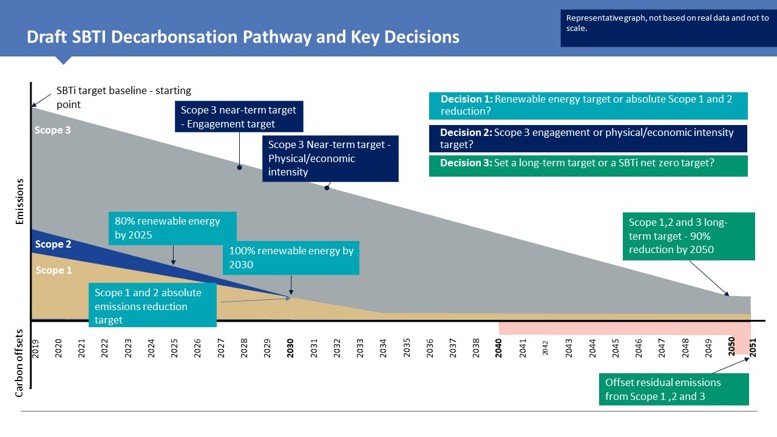Setting science-based targets for airports

Image courtesy Ricardo
Science-based targets are promoted and validated by the Science-Based Targets Initiative (SBTi). Science-based targets set out a clearly defined pathway for businesses to reduce greenhouse gas (GHG) emissions, helping prevent the worst impacts of climate change and future-proof business growth.
Without action to manage GHG emissions, climate change is likely to result in disruption and damage to infrastructure and loss of essential services. This may impede economic activity and cause societal and environmental impacts. Climate change is a critical risk to aviation and momentum to addressing climate change is building.
Targets set are ‘science-based’ if they are aligned to the latest climate science and what it considers necessary to limit global warming to 1.5°C above pre-industrial levels, the most ambitious goal of the Paris Agreement. A science-based target provides a public commitment, to passengers, industry, investors, governments, and regulators, that your organisation is committed to reducing your GHG emissions and the SBTi provides a framework for measuring your decarbonisation progress.
Near-term science-based targets outline what companies will do now and over the next 5-10 years to reduce emissions in line with a net zero pathway. Long-term science-based targets convey the destination of a company’s decarbonisation journey. These targets indicate the emissions reductions needed to achieve net zero, which for most companies will be at least a 90% reduction in emissions by 2050 at the latest—presenting a significant challenge and requiring a lot of investment.
The SBTi Standard stipulates the following requirements for minimum boundary coverage for science-based targets:
- Scopes 1 and 2: 95% minimum coverage for both near-term and long-term targets.
- Scope 3:
- Near-term targets: 67% minimum coverage (if Scope 3 emissions are at least 40% of total Scope 1, 2 and 3 emissions); and
- Long-term targets: 90% minimum coverage.
Science-based targets and defined pathways for decarbonisation can also support achievement of certification at the higher levels of the Airport Carbon Accreditation (ACA) scheme, with Airports Council International (ACI) Europe having recently announced their latest ‘net zero’ Level 5. To achieve ACA Level 5, airports need to reach and maintain net zero emissions for Scopes 1 and 2 and commit to achieving net zero in Scope 3 by 2050 or sooner.
What does this mean for airports?
Airports need to monitor and manage emissions from all of their operations (Figure 1), including Scope 1 and 2 emissions that the airport operator have direct control over (Scope 1 emissions from owned or controlled sources, notably from stationary and mobile combustion, and Scope 2 indirect emissions from purchased energy). As a key component of a science-based target, an airport must also take responsibility for indirect Scope 3 emissions that they can guide and influence (Scope 3 emissions include all aircraft emissions, passenger and staff transport, and smaller sources of emissions such as waste management).

Figure 1: Scope 1, 2 and 3 emissions (Adapted from the GHG Protocol)
Typically, Scope 3 emissions at an airport can account for more than 90% of emissions, with aircraft emissions being by far the largest source of airport-related emissions. This creates complexity for airport operators in managing the full value chain of their emissions, as they do not have direct control over their largest source of emissions. Managing these emissions will be very challenging. Ricardo has already been tackling these challenges with our airport clients, identifying initiatives and developing solutions to reduce their Scope 3 emissions.
It is very clear that a collaborative approach across many different stakeholders is going to be needed to drive the change needed to meet a science-based target.
Airports will need to work with airlines in managing aircraft emissions, with recognised decarbonisation levers including driving uptake of sustainable aviation fuels (SAF), improved efficiency of fleet and ground operations, and investment in technological advancements of future aircraft types. This will require significant investment and coordination. With such a substantial proportion of an airport’s emissions lying within their sphere of influence, but outside of their direct control, it can be challenging to model the most appropriate decarbonisation pathway and set suitable science-based targets.
Airport operators have taken varying approaches to setting science-based targets for their Scope 3 emissions. Just a handful of airports globally have officially committed to a science-based target through the SBTi, with five airport operators having set near-term targets (as listed in the SBTi target dashboard in December 2023), of which only two have set long-term targets. But the pace is increasing, and Ricardo is speaking to an ever-increasing number of our airport clients about their ambitions for setting science-based targets.
Among those airport operators with existing targets, Heathrow Airport has committed to 67% of its suppliers by emissions setting science-based targets by 2027. Whereas Royal Schiphol Group have committed to absolute reductions in their Scope 3 emissions in their near-term (35% by 2029 from a 2019 baseline) and long-term targets (90% by 2050). Airports also have the option to set an intensity-based target either on a physical or economic element of an organisation, such as a target based on passenger numbers. Intensity-based targets require a higher annual reduction value to meet the SBTi criteria but can benefit airports still experiencing the impacts of the COVID:19 pandemic on their operations and expecting a short-term growth in emissions as they return to normal operations. The most appropriate target setting method can vary by organisation.
The methodology for setting science-based targets can prove complex, so Ricardo recommends seeking expert support in the process of setting a science-based target. Ricardo has been working with clients to help them navigate the SBTi Standard, setting out measures that can be implemented to achieve decarbonisation targets. It has experience reviewing and improving emissions inventories, to ensure an airports emissions inventory is suitable for SBTi submission.

Figure 2: Representation of science-based target options and decisions available to an airport (Note: not all target criteria included here for ease of viewing)
Not sure how to progress with setting a science-based target with the SBTi? Looking to develop a climate transition plan for your business? Ricardo can provide support and help you to understand what the SBTi Standard and guidance means for you and the most appropriate target setting method for your airport.
Of course, setting a decarbonisation target is just one step. Delivering on the target is even more critical. Many other Environmental Social and Governance (ESG) reporting frameworks, such as GRI, TCFD, CDP, SASB, ISSB and ESG raters (including MSCI, SustainAlytics, ISS and FTSE Russell) also interact with science-based targets. ESG ratings agencies play a crucial role in assessing and rating companies' sustainability performance, including their adherence to science-based targets. They consider a company's progress toward achieving its science-based targets and examine whether the company is on track to meet its goals, as well as the effectiveness of its strategies and initiatives to reduce emissions.












